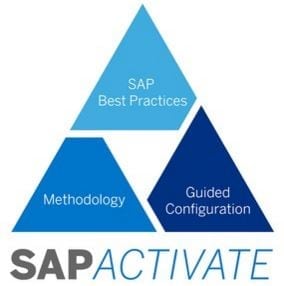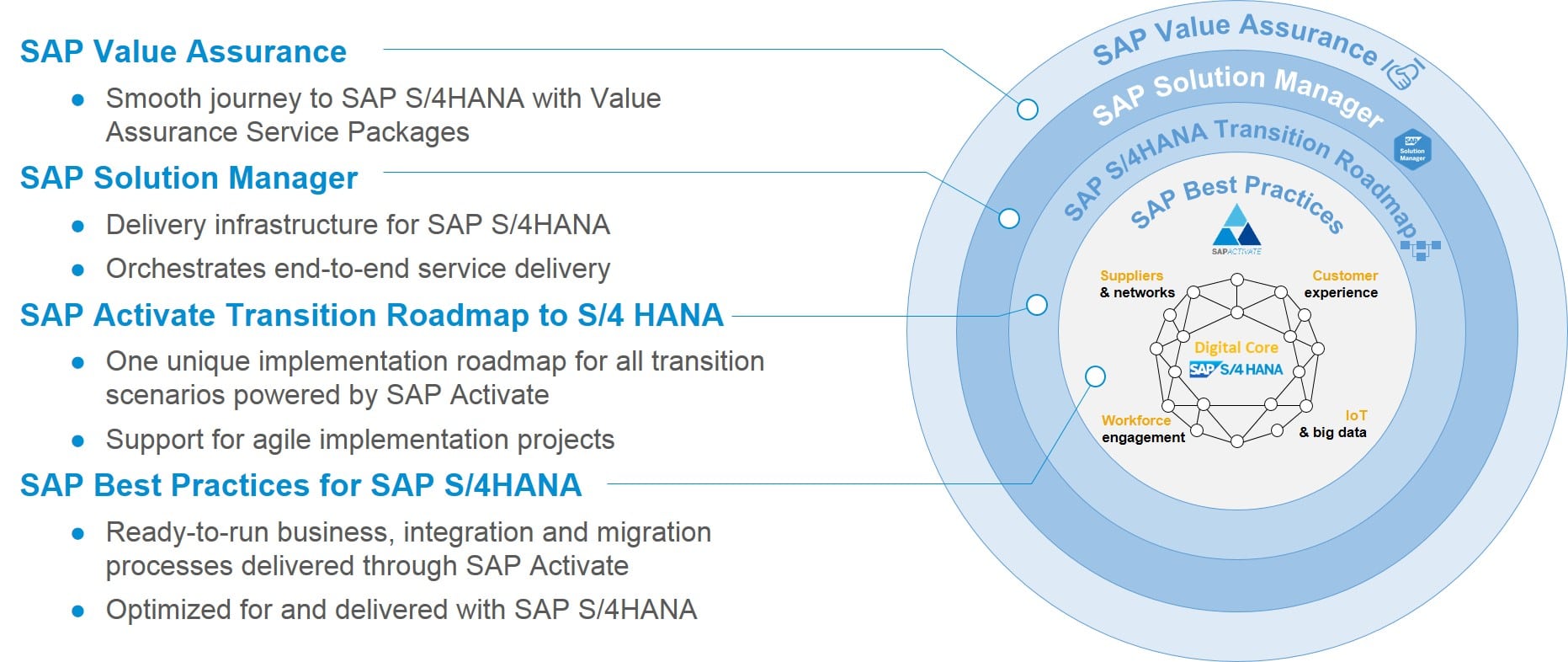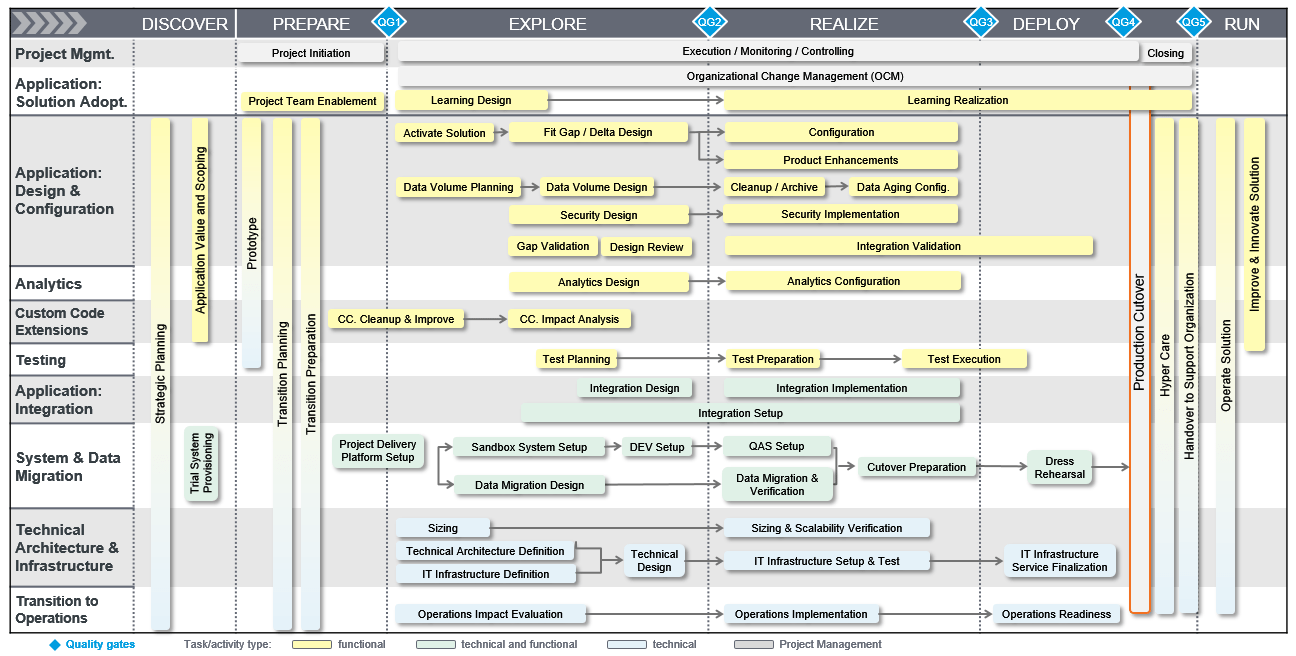How to use SAP Activate for your SAP S/4HANA Roadmap
CIOs, IT Directors, SAP project managers and consultants involved in SAP S/4HANA on-premise or cloud implementations, upgrades, migrations or conversion projects can benefit from using SAP Activate Implementation Methodology – an agile way for companies to implement SAP software. SAP Activate is the successor of ASAP (Accelerated SAP) methodology that was extensively used for SAP ECC implementations and upgrades projects. SAP Activate implementation methodologies are not just available for SAP S/4HANA cloud or on-premise but also for SAP BW/4HANA, SAP SuccessFactors, SAP C/4HANA (formerly known as SAP Hybris), and SAP Ariba.

SAP Activate leverages the SAP best practices to explore solutions for a company’s specific business scenarios and propose the most relevant solutions. Instead of preparing business blueprint document to cover every business scenarios, SAP Activate gets straight to conducting fit-gap analysis (known as Fit-to-Standard in SAP Activate) and leverages SAP best practices as well as rapid deployment solutions to see how best the SAP system addresses the features and functionality gaps.

Figure 1: SAP Activate – The Big Picture (Image credit: SAP)
SAP Activate implementation methodology consists of the following six phases:
• Discover phase
• Prepare phase
• Explore phase
• Realize phase
• Deploy phase
• Run phase
• Discover phase
• Prepare phase
• Explore phase
• Realize phase
• Deploy phase
• Run phase

Figure 2: SAP Activate Implementation Methodology (Image credit: SAP)
Let’s discuss each of the six phases of SAP Activate in some detail. For the purpose of simplicity and understanding, we’ll only be discussing SAP S/4HANA on-premises implementation but the same approach can also be adopted with other SAP software:
The Discover Phase
In this phase, the project teams discover the SAP solution’s capabilities, so as to better understand the business value and benefits of implementing S/4HANA. It also enables the team to define the target technology architecture as well as determine the implementation strategy to follow. This phase also enables the business users to prepare the business case for implementing SAP S/4HANA as well as preparing the deployment roadmap of the digital transformation journey.
You can explore the free trial versions of SAP S/4HANA cloud and on-premise via the following link.
In this phase, the project teams discover the SAP solution’s capabilities, so as to better understand the business value and benefits of implementing S/4HANA. It also enables the team to define the target technology architecture as well as determine the implementation strategy to follow. This phase also enables the business users to prepare the business case for implementing SAP S/4HANA as well as preparing the deployment roadmap of the digital transformation journey.
You can explore the free trial versions of SAP S/4HANA cloud and on-premise via the following link.
The Prepare Phase
In this phase, the initial project planning and preparation at the project management level takes place, which entails preparing the project plan for the S/4HANA implementation as well as team assignments. Other critical activities of this phase are defining the S/4HANA project’s goals, identifying and quantifying business value objectives for implementing S/4HANA. Executive sponsorship is secured and project standards, governance and organization are established. Reporting and tracking the project’s progress is finalized. The roles and responsibilities of the project team are also finalized in this phase.
In this phase, the initial project planning and preparation at the project management level takes place, which entails preparing the project plan for the S/4HANA implementation as well as team assignments. Other critical activities of this phase are defining the S/4HANA project’s goals, identifying and quantifying business value objectives for implementing S/4HANA. Executive sponsorship is secured and project standards, governance and organization are established. Reporting and tracking the project’s progress is finalized. The roles and responsibilities of the project team are also finalized in this phase.
The Explore Phase
In this phase, the business users explore the SAP best practices and standard business processes (known as Fit-to-Standard) such as order-to-cash, procure-to-pay or hire-to-retire that are mapped for S/4HANA. Sample data of a fictitious company is also available to enable business users to run the end-to-end processes to evaluate how closely a standard solution meets the company’s business needs. Here, the business users and the SAP consulting firm agree on the configurable objects required for the company. Configurable objects can be a company code responsible for all legal and financial reporting, a plant that can also be a manufacturing unit or a head office, a warehouse or sales organizations such as one is responsible for local sales while the other handles export sales. A complete fit-gap exercise ensures greater visibility of the gaps that the standard S/4HANA is unable to offer. In such cases, a fit-gap strategy decides if a system’s enhancement, a customized application, or activating a business add-in will address the identified gaps.
Additional but critical activities of this phase include master data load preparation, wherein data templates in MS-Excel are shared with the business users so they start working on and preparing clean, correct and comprehensive master data for loading in the S/4HANA system. Further, an initial groundwork on SAP testing and training’s needs also take place in this phase. A special emphasis is placed on planning the integration testing that entails bringing people, processes and teams working together in an ‘integrated’ or in a closed-loop environment.
In this phase, the business users explore the SAP best practices and standard business processes (known as Fit-to-Standard) such as order-to-cash, procure-to-pay or hire-to-retire that are mapped for S/4HANA. Sample data of a fictitious company is also available to enable business users to run the end-to-end processes to evaluate how closely a standard solution meets the company’s business needs. Here, the business users and the SAP consulting firm agree on the configurable objects required for the company. Configurable objects can be a company code responsible for all legal and financial reporting, a plant that can also be a manufacturing unit or a head office, a warehouse or sales organizations such as one is responsible for local sales while the other handles export sales. A complete fit-gap exercise ensures greater visibility of the gaps that the standard S/4HANA is unable to offer. In such cases, a fit-gap strategy decides if a system’s enhancement, a customized application, or activating a business add-in will address the identified gaps.
Additional but critical activities of this phase include master data load preparation, wherein data templates in MS-Excel are shared with the business users so they start working on and preparing clean, correct and comprehensive master data for loading in the S/4HANA system. Further, an initial groundwork on SAP testing and training’s needs also take place in this phase. A special emphasis is placed on planning the integration testing that entails bringing people, processes and teams working together in an ‘integrated’ or in a closed-loop environment.
The Realize Phase
In this phase, a series of activities incrementally build, test and validate the business scenarios and processes identified in the previous phase (the Discover phase). Master data is loaded to check and validate the correctness and completeness that ensure smoother, error-free transactions and business processes’ working. All custom-developed objects are also tested in the realize phase. Key business users are trained as ‘trainers’ with the objective that these SAP trainers will eventually train the end users (the train-the-trainer approach). End-users’ training is also planned so that relevant end users can be engaged at the right time and be trained only in their specific areas of working. The business users and SAP consultants delve deep into end-to-end integration testing involving different SAP components to ensure the data and information flows from and into various SAP components are complete and correct.
In this phase, a series of activities incrementally build, test and validate the business scenarios and processes identified in the previous phase (the Discover phase). Master data is loaded to check and validate the correctness and completeness that ensure smoother, error-free transactions and business processes’ working. All custom-developed objects are also tested in the realize phase. Key business users are trained as ‘trainers’ with the objective that these SAP trainers will eventually train the end users (the train-the-trainer approach). End-users’ training is also planned so that relevant end users can be engaged at the right time and be trained only in their specific areas of working. The business users and SAP consultants delve deep into end-to-end integration testing involving different SAP components to ensure the data and information flows from and into various SAP components are complete and correct.
The Deploy Phase
In this phase, the master trainers conduct the end-users training. The cutover activities, in which the company transitions from legacy systems to S/4HANA, take place. Some of the critical cutover activities include preparing the SAP production system with final master data uploads, uploading the cutover or the closing financial and inventory balances from the legacy systems into S/4HANA, testing and validating all roles and authorizations for business users and end users. The change management activities culminate with all stakeholders aligned for ensuring a transition to S/4HANA is not only accepted but is also smooth. The S/4HANA system goes live and business and end users can begin entering the data by starting with first entering the backlog data that accumulated during the transition from the legacy systems to S/4HANA (this period is known as the ‘blackout’ period in which no data is entered into the legacy systems).
In this phase, the master trainers conduct the end-users training. The cutover activities, in which the company transitions from legacy systems to S/4HANA, take place. Some of the critical cutover activities include preparing the SAP production system with final master data uploads, uploading the cutover or the closing financial and inventory balances from the legacy systems into S/4HANA, testing and validating all roles and authorizations for business users and end users. The change management activities culminate with all stakeholders aligned for ensuring a transition to S/4HANA is not only accepted but is also smooth. The S/4HANA system goes live and business and end users can begin entering the data by starting with first entering the backlog data that accumulated during the transition from the legacy systems to S/4HANA (this period is known as the ‘blackout’ period in which no data is entered into the legacy systems).
The Run Phase
In this phase, the S/4HANA system is further stabilized by ensuring all of the possible issues, errors or incorrect entries that may have occured during the first few days of S/4HANA going live are quickly corrected. Establishing a dedicated IT or SAP helpdesk to resolve such issues goes a long way towards the smoother working of S/4HANA. Here, the business users again play a critical role in ensuring trouble-free S/4HANA, by closing working with a company’s internal SAP helpdesk as well as with SAP consultants to quickly and comprehensively resolve the issues faced. A successful and timely financial closing of the first month within the S/4HANA is a litmus test to validate the correct and reliable business processes’ working.
Figure 3 shows the end-to-end SAP Activate implementation methodology roadmap involving the six phases, the tasks and activities involved in each phase, and the quality gates (QGs – the blue diamonds) that are necessary to ensure timely and effective SAP software implementation.
In this phase, the S/4HANA system is further stabilized by ensuring all of the possible issues, errors or incorrect entries that may have occured during the first few days of S/4HANA going live are quickly corrected. Establishing a dedicated IT or SAP helpdesk to resolve such issues goes a long way towards the smoother working of S/4HANA. Here, the business users again play a critical role in ensuring trouble-free S/4HANA, by closing working with a company’s internal SAP helpdesk as well as with SAP consultants to quickly and comprehensively resolve the issues faced. A successful and timely financial closing of the first month within the S/4HANA is a litmus test to validate the correct and reliable business processes’ working.
Figure 3 shows the end-to-end SAP Activate implementation methodology roadmap involving the six phases, the tasks and activities involved in each phase, and the quality gates (QGs – the blue diamonds) that are necessary to ensure timely and effective SAP software implementation.

Figure 3: Quality Gates in SAP Activate Implementation Methodology (Image credit: SAP)
It will not be long before SAP Activate implementation methodology will be the de facto approach for companies to follow for their SAP software implementation and upgrades. Therefore, it makes sense for CIOs, project managers and SAP consultants to quickly enable themselves on SAP Activate, and arm themselves against the unexpected challenges of an SAP S/4HANA implementation. Fortunately, a plethora of resources are available to make this enablement possible and easier.
Where to find further information about SAP Activate:
Source: https://eursap.eu/2018/08/28/blog-sap-activate-s4hana-roadmap/
Great insights on SAP!
ResponderExcluirWorkday SCM Online Training And Certification Course
Thank you for sharing such an insightful piece. Your perspective on the topic is enlightening. I'm eagerly awaiting your next article.
ResponderExcluirSAP Hybris (DEVELOPER & FUNCTIONAL) Online Training